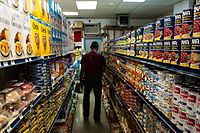
Photo from wikipedia
Home food availability (HFA) checklists can be completed by self-report to assess the home food environment. Checklists developed for Black/African American (B/AA) and Hispanic/Latinx (H/L) households are seldom validated against… Click to show full abstract
Home food availability (HFA) checklists can be completed by self-report to assess the home food environment. Checklists developed for Black/African American (B/AA) and Hispanic/Latinx (H/L) households are seldom validated against objective approaches such as exhaustive in-home food inventories. This study validated a self-report HFA checklist developed for B/AA and H/L households (n = 97) against researcher-completed HFA checklists verified by exhaustive in-home food inventories. Mean estimates of sensitivity, specificity, and area of the receiver operating curve (ROC), and interrater agreement (Gwet AC1) were calculated to examine the accuracy and agreement of self-reported checklists against direct observation of individual food items. Mean differences in HFA food group scores were compared (self-report vs observed) to examine group-level relative validity. The predictive validity of this self-reported measure on observed scores and dietary intake were also examined with linear regression. The average values for ROC area (average of sensitivity and specificity) ranged from acceptable (0.76 for sweets) to excellent (0.81 for vegetables, fruits). Average interrater agreement values ranged from moderate (0.41-0.60: sweets) to substantial (0.61-0.79: vegetables, fruit, SSBs, savory foods). Self-reported mean scores, compared to observed scores, were higher for vegetables (mean diff: 1.04) and lower for sweets (mean diff: 0.38, p = 0.01), but regression analyses demonstrated that self-reported scores were good predictors of observed scores with absolute error (based on standard deviation of residuals) ranging from ±1.27 to 1.69 points. Self-reported scores also predicted multiple aspects of dietary intake but more so among H/L households. In conclusion, the HFA checklist obtained via self-report performed well based on multiple indicators of validity suggesting that this self-reported measure can be used to assess home food environments among of B/AA and H/L households.
Journal Title: Appetite
Year Published: 2022
Link to full text (if available)
Share on Social Media: Sign Up to like & get
recommendations!